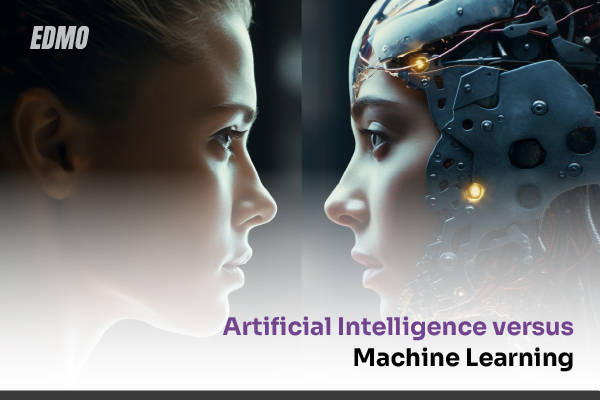From education to healthcare, industries to homes, AI and ML have revolutionized technology, introducing us to a whole new dimension of possibilities. Their transformative impact spans across all sectors, but their role in education stands out as truly groundbreaking. With the global AI in education market valued at USD 5.88 billion in 2024 and projected to grow at a remarkable CAGR of 31.2% from 2025 to 2030, the demand for personalized learning experiences continues to drive innovation. Despite these advancements, there is immense potential to achieve even more. Read on to explore the multifaceted impact of AI and ML on our lives, particularly their revolutionary contributions to education.
Technology and its impact on our lives
Technology is the sum of many techniques, skills, methods, and processes used in producing goods and services or for the accomplishment of objectives. From the prehistoric days to the 21st century, technology has changed drastically from simple handmade tools to complicated pieces of machinery. Every decade brings technological improvements that make our lives easier, like transportation, access to food, healthcare, education, safety, productivity, and socialization.
The power of the internet has transformed the world into a global village, wherein obtaining information on various happenings and socializing with people from all over the globe has become a cakewalk. While the internet is a boon for us, it poses numerous risks as well. It has been linked with knowledge, yet its overuse can lead to deterioration of mental health, heightened social disparity, and privacy issues. Technology has been at our beck and call – from making the Consommé Devilish dish (one of the most challenging dishes in the world) to connecting us with our family members living seven seas away. Thus, taking technology for granted would be our greatest mistake.
Out of all the major technological inventions, Artificial Intelligence and Machine Learning are two of the amazing creations that have phenomenal potential to change the future of the world. AI and ML are quite ballyhooed terms, often used by people interchangeably to describe perspicacious software. Though both are based on mathematical calculations, they are quite different in their functions and usage. Let’s explore these topics individually while looking at their usage in the field of education.

Artificial Intelligence
1. What do you mean by Artificial Intelligence?
Artificial Intelligence, or AI, is nothing but a machine’s ability to emulate human intelligence and execute chores just like any normal Homosapien. All the intellectual aptitudes of human beings, like thinking, logic, learning through experience, and making decisions on their own, can be replicated through AI. And though AI can execute the assigned duties with remarkable accuracy, it has not yet accomplished the task of emotionally interacting with human beings.
2. Types of Artificial Intelligence
There are two ways in which AI can be classified-
- Based on AI-enabled machines’ likeness to the human mind-
- Reactive Machines: While having no memory, it simply responds to different types of stimuli.
- Limited Memory: This kind of memory has the ability to learn and improve its responses.
- Theory of Mind: This can comprehend the needs of other intelligent machines.
- Self-Aware: It possesses human-like intelligence and the quality of self-awareness.
- Based on technical language–
- Artificial Narrow Intelligence: Can only perform a specific task independently using human-like intelligence.
- Artificial General Intelligence: Ability of AI to comprehend, understand and operate as a human being.
- Artificial Superintelligence (ASI): Apart from replicating human intelligence, ASI will have the ability to store a larger amount of information, have greater memory, faster data processing, examination, and decision-making capabilities.
3. Features and uses of AI
Artificial Intelligence might sound like a far-fetched idea, but in reality, numerous technological developments make use of AI to empower us and make our lives easier. Below mentioned are some of the common uses of AI in our everyday lives-
- Navigation Apps: Daily commuting apps like Google Maps use AI to detect the speed of traffic, the time needed to reach one particular place, and the probability of incidents like accidents or traffic delays.
- 3D Photography: Photography apps like LucidPix use AI to capture 3D photos and convert 2D into 3D pictures. This app can identify the parts of the photograph that have higher and lower levels of depth. With just one click, it can bring pictures to life.
- Facial Recognition: Facial recognition has become quite common in electronic devices, offices, organizations, and apps like Facebook, Instagram, Snapchat. AI is used to recognize various parts of the face and help us to apply filters to our photos. Governments and organizations also use this feature to identify their employees and give them entry into private premises.
- Smart Assistants: AI-powered personal assistants like Siri, Alexa, and Google Assistant take in your voice commands and transform them into actions.
- Online Banking: Online banking facilities are no longer limited to only transferring and receiving money. Nowadays, with the help of AI, mobile cheque deposit services are also made available to the customers, wherein your signatures can be scanned and identified. AI also plays a huge role in identifying fraudulent transactions and recognizing the credit score of new customers.

Machine Learning
1. What do you mean by Machine Learning?
Machine Learning can be defined as a subset of AI. ML can automatically learn from a given piece of information by being modified, programmed, or assisted by an individual with domain expertise. Specifically, with regards to the ‘Learning’ in Machine Learning, we could say that the machine can learn based on data, and an ML calculation can prepare a model, test its performance, and last but not least, make auguries. The main aim of ML is to allow the machines to learn on their own using the data provided to them and make correct auguries.
Types of ML
ML algorithms are used to solve various business problems like regression, classification, forecasting, clustering, associations, and many more. Thus, based on methods and ways of learning, ML has been divided into the following four categories-
- Supervised Machine Learning: Training machines using a ‘labelled dataset.’ For example, Housing Price Prediction, Medical Imaging.
- Unsupervised Machine Learning: Training machines using an ‘unlabeled dataset.’ For example, Customer Segmentation, Market Basket Analysis.
- Semi-Supervised Machine Learning: Training machines using the combination of both labelled and unlabeled datasets. For example, Text Classification, Lane Finding on GPS Data.
- Reinforcement Learning: Training machines using feedback-based processes. For example, Optimized Marketing, Driverless Cars.
Features and uses of ML
Machine Learning is considered one of the most incredible innovations in the field of technology. From being a fanciful concept in sci-fi movies, today, Machine Learning has become a reality. Below mentioned are some common uses of ML in our daily lives-
- Self-Driven Cars and Automated Transportation: Modern aircraft have now started implementing a Flight Management System – a fusion of GPS, computer systems, and motion sensors – that allows one to track the position of the aircraft. Besides, self-driven cars have also become quite popular and have surpassed human-driven cars in terms of safety.
- Cyborg Technology: As we know, our brains and bodies have limitations. However, with the help of ML, the majority of these advantages could be overcome, thereby increasing our natural efficiency and intelligence.
- Taking Over Dangerous Jobs: Many dangerous jobs like bomb diffusion and welding can sometimes be life-threatening to human beings. Machine Learning has been modified to such an extent that drones, which humans control, can be used to diffuse bombs, and welding work can be outsourced to robots.
- Digital Empathy: Though robots are said to be emotionless creatures, a company in Japan proved this wrong. In 2014, this company introduced a robot named Pepper that was programmed in such a way that it could relate to human emotions, develop its sentiments and act as a companion to its buyers.
- Environmental Protection: Machines can store data in huge quantities, including some mind-boggling numbers and statistics. Using such data, IBM’s Green Horizon Project analyzed environmental data and produced accurate results on weather conditions, pollution problems, carbon footprints, etc.

Difference between Artificial Intelligence and Machine Learning
| Artificial Intelligence | Machine Learning |
|---|---|
| Artificial Intelligence has been defined as the science and engineering of making intelligent machines. | Machine Learning has been defined as the field of study that gives computers the ability to learn without being explicitly programmed. |
| AI aims to increase the chance of successful outcomes. | ML aims to increase precision. |
| AI is a computer program that does smart work by replicating human intelligence. | ML works on the concept of taking the information provided to it and learning from it. |
| The objective is to recreate normal insight to take care of the baffling problems. | The objective is to gain knowledge from information on specific undertakings to augment the execution of machines of a particular task. |
| AI works on the principle of decision-making. | ML works on the principle of learning new things from the provided data. |
| It develops a framework to replicate human intelligence qualities and as a result, acts accordingly in different situations. | It develops a framework where it is involved in self-learning. |
| AI focuses on finding the perfect solution. | ML focuses on finding solutions and it doesn’t matter if the solution is not perfect. |
| AI gives rise to intelligence. | ML gives rise to knowledge. |

Use of AI and ML in education
For a long time, sci-fi movie writers, prognosticators, and filmmakers have been anticipating the stunning (and, in some cases, catastrophic) changes that will emerge with AI development. Until this point, AI hasn’t caused any such insane ripple effects and, in numerous ways, has discreetly become universal in various parts of our regular routines. From the intelligent sensors that assist us in taking amazing pictures to programmed vehicle parking devices and the occasionally disappointing personal assistants in cell phones, man-made brain powers of one sort or another surround us everywhere.
While we may not see humanoid robots going about as educators in the following decade, many ventures currently in progress utilize computer intelligence to help pupils and instructors get more out of the learning experience. Here are a couple of jobs that man-made marvels like AI and ML perform in education, and those that will follow them will shape and characterize the educational experiences to come.
Artificial intelligence and Machine Learning play significant roles in three educational sectors-
- Higher Education: Distinguish and draw in the right pupils, estimate enlistment, foresee results, and guarantee student achievement – all of this is possible through the application of AI. The research process can be paced up by simplifying ML and making it less expensive to use for research exercises and training sessions. Modernizing the campus experience and making the campus security more intelligent and effective would enhance the student experience.
- K12 and Primary Schools: Recognizing in-danger pupils and target intercessions have become hassle-free. Using AI, edtech companies can offer internet-based self-assistance apparatuses for guardians and students. Improving campus security with ML-controlled danger spotting and immediate mitigation can make the students feel safe and secure. Further, developing instructor effectiveness and improving the learning experience with customized content and AI-empowered teaching assistants and guides are some of the benefits of AI, along with developing the productivity of assessments and evaluations.
- EdTech and Learning Companies: Reaching out to global customers and serving them via transcription, content classification, text-to-speech, and translation facilities can bring the clients closer to your business. Utilizing personalized learning, self-serving capacities, and student-friendly chatbots can be some useful add-ons. Marketing, advertising, and student outcome become easier to track with AI and ML.
Uses
Apart from AI and ML’s role in these education sectors, they hold many other benefits for students and teachers. Some of these are enlisted below-
- Adaptive Learning: As the name suggests, adaptive learning is the process by which a program working on the principle of Machine Learning analyzes a student’s performance and modifies the learning and teaching method to help the student effectively adapt to the curriculum. The program adapts to the student’s learning styles to give them a better experience.
- Learning Analytics: There are times when the teacher is stuck with certain concepts of a chapter, and as a result, students don’t get a proper understanding of that particular concept. Learning analytics can provide teachers with various resources, including videos, audio, and texts on different concepts. As a result, they can understand that concept better and further explain it to the students.
- Predictive Analytics: This concept is used to predict the mindset and needs of students. While analyzing student performance for various exams across years, their responses in classes, and their assignments, AI can predict students’ performance in the final exams. This alerts the faculty, parents, and students to start working on the weaker areas of the respective students in time.
- Personalized Learning: The concept of personalized learning has become quite popular nowadays and is perhaps one of the best advantages of Machine Learning. Customizing the study module according to students’ needs and capabilities can allow them to enjoy the learning environment. Students can learn at their own pace and decide what to learn and how.
- Evaluating Assessments: We all have heard of OMR sheets and how their results are calculated by using the OMR Sheet Design Software. AI has developed to such an extent that it can check handwritten student assignments and exam answer sheets with amazing accuracy.
- Producing Smart Content: With the development of AI and ML, the learning process has become a lot more engaging and interesting. These technologies have facilitated the creation of digital lessons, which include digital textbooks, bite-sized videos, online practice tests, and more.
Conclusion
Now that we understand the concepts of Artificial Intelligence and Machine Learning and their differences, we have an idea of the tremendous potential they hold for the field of education. AI and ML, combined together, will not only improve the learning landscape but also help the education industry flourish even in tough times like COVID-19. So, what do you think? Will an amalgamation of Artificial Intelligence, Machine Learning, and Human Abilities help us progress towards a society where technology would assist us in every possible way?

Also read: Demystifying SOP and Essay Analysis with AI Solutions
Crisis in Enrollment: Strategies to Recover and Grow Your Student Body
Maximizing Enrollment Efficiency: The Power of Automation
EDMO and One Education join forces to help Southeast Asian study abroad aspirants
AI-Driven Career Pathways: Transforming Career Services for Graduates







